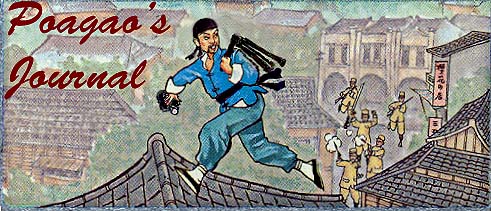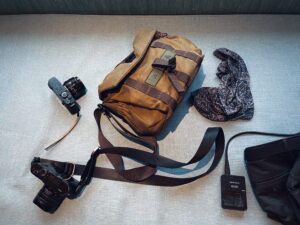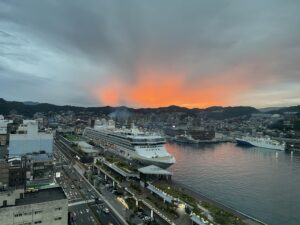I was awoken this morning by the clotheswashing machine churning away in the next room at around 6 a.m. So, it being quite cold in my room, I turned on the heater to drown out the intermediate noise with constant noise. A while later I was again woken by a phone call from the front desk. “Can you turn off your heater?” she asked. “The dripping water is keeping the guest downstairs awake.”
“By ‘the guest downstairs’, do you mean Prince Roy?” I asked.
“Yes, and he wants you to cut it out,” she said. So I turned it off. It was almost 7 by this point, so I gave up on sleep and just got dressed. Outside, the Taima ferry plowed through the waters on its way from Dongyin to the port here. It looked like the makings of a beautiful day outside, a little cloudy but dry. PR was watching the Yankees game on TV, but we had to catch the boat to Beigan for the day.
Despite waiting forever for the people in front of us to buy tickets down at the port, we just made the 9:00 a.m. boat, along with a dozen other passengers. The boat was about the size and shape of the USS Minnow, and the pilot drove it like a bus. PR had the window open and was told to shut it, a wise decision as it was sprayed with water once we got out into open ocean.
The port at Beigan seems to be in the middle of nowhere, and you have to take a taxi to the main village by the airport, or so we’d been informed. Actually there were scooter rental places right there, but we didn’t see them. We shared a taxi with a couple instead.
The main village of Tongxi isn’t much to look at. It’s basically two streets, once perpendicular to the other. I took pictures of a KMT emblem while PR rented a pair of scooters, and then we were off. We rode up steep, curving roads past military base after military base to the top of Bishan, where an observation platform was located right in front of yet another military base and a sign saying “No pictures.” Gunfire and shouts echoed clearly up from below where soldiers were training. I asked the guard at the gate when the planes usually landed, and he said one was due in a few minutes, so we waited. Powerful strobe lights began to flash on the tops of all the nearby mountains, and we heard the sound of a small propellor plane approach, and then disappear. We saw no plane. The weather wasn’t bad, so I can’t believe they cancelled the landing because of that.
Disappointed, we got back on our scooters and rode down to the coast to look at a series of temples along the coast. Temples in Matsu look different from their counterparts in Taiwan, with more reds and yellows and whites involved. We saw one temple just for female gods, with a phoenix motif and two female lions out front. We looked for the Thunder God temple, which I pictures as a kind of superhero god, hopefully wearing a cape of some kind, but we didn’t find it. Nobody knew what we were talking about when we asked them.
We continued down the coast to the Chinbi village, which is inordinately cool. For one thing, it’s been preserved, and all new buildings have to be built like the old ones. The community of stone houses faces a small beach with a turtle-shaped island not far off shore, and is apparently home to visiting artists who live there to “create”. We parked our scooters and walked into the complex, noting the many old signs harking back decades, with slogans like “Retake the Mainland” and “Look Out for Commie Spies!” The place was filled with interesting little nooks and crannies, sunny verandas and shady courtyards. One interesting motif was the use of frogs in the design. We even found a room full of various frog-related statuary. It seems that long ago, the village was besieged by drought and disease, and after praying to Matsu, relief appeared in the form of rainfall, and frogs, so frogs here are kind of like cows in India, i.e. not on the menu.
At the local Matsu temple, another surprise awaited us. In addition to all the flowers and notes wishing Matsu a happy birthday, on the altar lay the latest Pizza Hut pizza with all the toppings, a bucket of KFC and a bottle of Pepsi. Matsu is living it up this year, it seems.
We had lunch at the Chinbi Cafe, sitting out on the patio while a stray cat begged loudly for scraps. I wondered if it had eaten any frogs. We met the people who had donated the fast food at the altar; they had originally planned to take the plane the day before, but it was canceled (probably the same flight Mark was supposed to be on), so they took the ferry over, carrying the delicacies with them at great inconvenience. Now that’s dedication.
The food at the Chinbi Cafe was delicious and the view unsurpassed as the sun came out, the blue sky showing through the clouds. I asked the owner what renting places there was like in the summer, and was told it was very difficult. “It’s full of tourists during the high season,” he said. After lunch we walked around a bit more, exploring the place before getting back on the scooters and continuing on our way.
We stopped at a few more temples, including an old Matsu temple painted in a striking shade of yellow on a large, nice beach. In front of it was a field covered with yellow flowers, and next door was a small military unit. The soldiers were out in the courtyard polishing or painting things, but otherwise there was nobody around. The crash of the waves on the beach and birdsong were the only sounds. It was extremely peaceful and would be a good place to meditate. Another temple down the road had scenes from “Journey to the West” carved on its elaborate facade and a flashy ceiling inside.
We rode down to the ferry port and back, stopping at a couple of statues of late President Chiang Kai-shek, one with a jaunty hat, and then back to the airport and across a sand spit to Hou-ao village. We then waited at an intersection-free stoplight counting down to zero as a soldier on guard gave his comrades across the street the finger from his post atop a small building. When the inexplicable light turned green, we rode up into the hills, past some military displays to an observation deck at the edge of a sea cliff. Not content to merely tempt fate by standing too close to the edge, I went to get closer pictures to a bunch of “Danger: Landmines” signs nearby while PR climbed across a small rocky bridge and up to an outcrop of stone high above the waves. There was also a military museum with, ironically and suitably depending on your point of view, an alternative serviceman sitting at the reception desk overlooking the old guns and other military paraphernalia on display. The mannequins were all tall, thin and white Caucasian models that looked extremely odd wearing the green slickers and face paint.
The afternoon was wearing on as we rode back down to Hou-ao Village to have a look around. The community is located just at the edge of the hillside, in front of the channel of water between it and the airport. We happened upon a row of plastic bags hung out to dry, as well as several Beijing 2008 Olympic mascot figures in a pile, on bases that read, “Courtesy of The People’s Government of Gulou District.” Curious. In fact, we had already noted that many of the offerings at the temples were in fact Chinese goods. Another curiosity: an electricity bill stuck in the doorway of a building that looked as if it hadn’t seen any improvements since the Qing dynasty.
We rode back across the sand spit and under the airport runway to the scooter place to return our rides, stocked up on water at 7-Eleven, and walked along the street looking for a taxi. As we did so, we passed an old lady carrying fish noodle ingredients. She said hello, and PR noted that he had read about her in his guidebook.
Eventually we caught a tattered cab back to the port to catch the ferry. Unfortunately, we just missed the 4:30 p.m. boat, and had to wait an hour for the last boat back to Nangan. In the meantime, we sat at a nearby temple and talked about what we had seen so far, as a fishing boat docking up confused the two young coast guard members entrusted with registering the vessel. The tide was out and the water level was about two stories lower than it had been when we arrived.
The ride back was as uneventful as the ride there. PR nodded off while I waited impatiently for a wave to slap a woman across the cabin who had left her window open. Unfortunately, no such thing happened, and I had to content myself with capturing blurry photos of the mountains of Nangan across the sea.
The sun was setting when we arrived back at Nangan port. We caught a cab back to our hostel; the cabbie thought it strange that we would choose a place with a view over somewhere “in the middle of everything.” Yes, I came to Matsu for its urban sophistication and cosmopolitan nature; what was I thinking?
We walked down the hill to Yi-ma’s Shop, but found it awash with people, including a couple of shrieking children who thought I was a pirate. We decided to head instead to the temple by the bay instead, where we sat and ate garlic peanuts and cookies while catching glimpses of the stars overhead through the clouds. One of the temple doors was open, and we took a look at the spookily empty interior. The “guards” painted on the side gates were women, which is unusual. The ones on the main gates were done in 3D and looked unnaturally real in the night, as if they could step out and throttle you at any moment.
By the time we got back to the restaurant a bit after 8 p.m., the crowds had left, and sat down to another delicious meal prepared by Mrs. Chen and her crew. PR got a huge glass of laojiu, but I declined. Just like yesterday, the atmosphere was most relaxing. As we ate, we heard Taichung Mayor Jason Hu pimping out his city on the radio to Chinese tourists, and then an official from Miaoli did the same. “It has begun,” PR said. Mrs. Chen gave us some nice fried peanuts for dessert, and we made our slow, stuffed way back up the hill to the hostel, exhausted from all the sun, wind, riding and food. It was a full day and an interesting one.
Tomorrow afternoon we will have to board a plane back to Taipei and the relatively normal world. But before that we hope to explore this island of Nangan a little more via scooter.



 Gulangyu (“Drum Wave Islet”), as an old international settlement with cooler weather in the summer, is home to many old colonial buildings, as well as some of the most hideous wedding attire I’ve encountered. Groups roamed the streets, even on a weekday, loudspeakers blaring away at each other. We escaped the cacophony through mazes of alleys, talking with some of the elderly residents. We had the advantage of being able to communicate in Minnan, giving us a step up over Chinese people from other provinces, though only one of Chenbl’s co-workers speaks it really well; the rest of us don’t speak it that well, but we can get by. The old derelict buildings, many home to multiple families, reminded me of Qingdao or even Penang’s Georgetown, if it were left to rot for a century. Some of the buildings are nicely restored, however, including some interesting-looking hostels and restaurants. Many others were being worked on, stones being hauled up and down the narrow streets by men in overloaded carts. Above us, empty cable cars’ open doors swung freely, and an expert whistler accompanied his own guitar. We passed a military base inside which female soldiers were learning taijiquan. A unit of soldiers marched nervously past.
Gulangyu (“Drum Wave Islet”), as an old international settlement with cooler weather in the summer, is home to many old colonial buildings, as well as some of the most hideous wedding attire I’ve encountered. Groups roamed the streets, even on a weekday, loudspeakers blaring away at each other. We escaped the cacophony through mazes of alleys, talking with some of the elderly residents. We had the advantage of being able to communicate in Minnan, giving us a step up over Chinese people from other provinces, though only one of Chenbl’s co-workers speaks it really well; the rest of us don’t speak it that well, but we can get by. The old derelict buildings, many home to multiple families, reminded me of Qingdao or even Penang’s Georgetown, if it were left to rot for a century. Some of the buildings are nicely restored, however, including some interesting-looking hostels and restaurants. Many others were being worked on, stones being hauled up and down the narrow streets by men in overloaded carts. Above us, empty cable cars’ open doors swung freely, and an expert whistler accompanied his own guitar. We passed a military base inside which female soldiers were learning taijiquan. A unit of soldiers marched nervously past.




